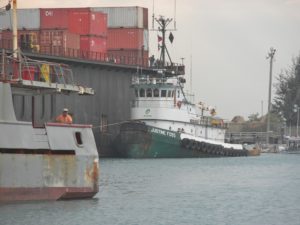Foss Assisted Post-Earthquake Relief Efforts in Haiti

The Justine Foss and barge American Trader arrived in Port-au-Prince on Feb. 1, 2010, with 6,150 tons of food,making the first post-earthquake delivery to Haiti.
The use of Foss owned and chartered equipment to assist in the post-hurricane relief in Puerto Rico brings to mind a similar major response in January of 2010 to support the country of Haiti after a devastating earthquake.
Within days of the earthquake which devastated much of the island nation, including the seaport of Portau- Prince, Foss through its subsidiary company, America Cargo Transport Corporation (ACTC), was marshalling a fleet of four tugs and barges to load emergency relief supplies in gulf coast ports for delivery to Port-au-Prince.
The first tug and barge combination, the Justine Foss under the guiding hand of Capt. Clare Nelson and the American Trader, loaded 6,150 tons of food staples in Houston and Lake Charles under a contract with the U.S. Agency for International Development. They arrived in Portau- Prince on Feb. 1, the first postearthquake delivery to the heavily damaged port.
Another Foss subsidiary, Gulf Caribe Maritime, provided the tug Caribe Pioneer to tow the barge, Foss 343 to assist the Military Sealift Command in lightering cargo from anchored ships to the beach. Two chartered tugs and barges rounded out the Foss-provided relief fleet.
The comment by ACTC director of cargo operations, Rob Wagoner, shortly after the earthquake struck was, “We went from our normal program of food aid deliveries to an emergency situation that required assets to be deployed immediately.”
In mid-February, ACTC was loading another barge in Houston, and the company continued its aid shipments to Haiti for a number of months, with the prime contractor being the World Food program.
Two years later, on October 29, 2012 Superstorm Sandy, made landfall in northern New Jersey. Even before Sandy finished its rampage on the East Coast, the federal government reached out to Foss Maritime, knowing of their successful work in Haiti in 2010, to provide disaster relief in devastated parts of New York and New Jersey.
The final estimate was $71.5 billion in damage; 650,000 homes destroyed or damaged, and at the peak of the storm, 8 million people had lost power. All modes of transportation were shut down, with many subways and rail lines under water.
No tugs or barges were involved in this response, but within hours Foss had relief supplies headed from locations across the country to Naval Air Station Lakehurst, N.J., the marshalling area for relief supplies and equipment. The Foss mobilization consisted of 26 pumps, six generators and the personnel to operate the equipment.
Foss employees remained at NAS Lakehurst well after the storm working to clean flood damage or provide electricity in communities on the New Jersey shore and parts of coastal New York, where after two weeks some services were still out.
A year after Hurricane Sandy struck the East Coast the federal government honored Foss Maritime for its part in the critical relief work.
Editor’s Note: Mike Skalley, retired billing manager, is the Foss historian and has written several books on the company.
